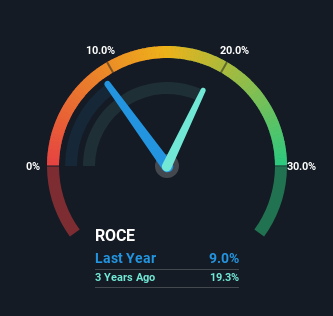- United States
- /
- Interactive Media and Services
- /
- NasdaqGS:CARG
Returns At CarGurus (NASDAQ:CARG) Appear To Be Weighed Down
What trends should we look for it we want to identify stocks that can multiply in value over the long term? Ideally, a business will show two trends; firstly a growing return on capital employed (ROCE) and secondly, an increasing amount of capital employed. This shows us that it's a compounding machine, able to continually reinvest its earnings back into the business and generate higher returns. In light of that, when we looked at CarGurus (NASDAQ:CARG) and its ROCE trend, we weren't exactly thrilled.
What Is Return On Capital Employed (ROCE)?
For those that aren't sure what ROCE is, it measures the amount of pre-tax profits a company can generate from the capital employed in its business. The formula for this calculation on CarGurus is:
Return on Capital Employed = Earnings Before Interest and Tax (EBIT) ÷ (Total Assets - Current Liabilities)
0.09 = US$85m ÷ (US$1.0b - US$109m) (Based on the trailing twelve months to September 2023).
Therefore, CarGurus has an ROCE of 9.0%. Even though it's in line with the industry average of 9.0%, it's still a low return by itself.
Check out our latest analysis for CarGurus

In the above chart we have measured CarGurus' prior ROCE against its prior performance, but the future is arguably more important. If you'd like to see what analysts are forecasting going forward, you should check out our free report for CarGurus.
How Are Returns Trending?
In terms of CarGurus' historical ROCE trend, it doesn't exactly demand attention. The company has employed 426% more capital in the last five years, and the returns on that capital have remained stable at 9.0%. This poor ROCE doesn't inspire confidence right now, and with the increase in capital employed, it's evident that the business isn't deploying the funds into high return investments.
One more thing to note, even though ROCE has remained relatively flat over the last five years, the reduction in current liabilities to 10% of total assets, is good to see from a business owner's perspective. Effectively suppliers now fund less of the business, which can lower some elements of risk.
In Conclusion...
In conclusion, CarGurus has been investing more capital into the business, but returns on that capital haven't increased. Since the stock has declined 35% over the last five years, investors may not be too optimistic on this trend improving either. Therefore based on the analysis done in this article, we don't think CarGurus has the makings of a multi-bagger.
While CarGurus doesn't shine too bright in this respect, it's still worth seeing if the company is trading at attractive prices. You can find that out with our FREE intrinsic value estimation on our platform.
For those who like to invest in solid companies, check out this free list of companies with solid balance sheets and high returns on equity.
New: AI Stock Screener & Alerts
Our new AI Stock Screener scans the market every day to uncover opportunities.
• Dividend Powerhouses (3%+ Yield)
• Undervalued Small Caps with Insider Buying
• High growth Tech and AI Companies
Or build your own from over 50 metrics.
Have feedback on this article? Concerned about the content? Get in touch with us directly. Alternatively, email editorial-team (at) simplywallst.com.
This article by Simply Wall St is general in nature. We provide commentary based on historical data and analyst forecasts only using an unbiased methodology and our articles are not intended to be financial advice. It does not constitute a recommendation to buy or sell any stock, and does not take account of your objectives, or your financial situation. We aim to bring you long-term focused analysis driven by fundamental data. Note that our analysis may not factor in the latest price-sensitive company announcements or qualitative material. Simply Wall St has no position in any stocks mentioned.
About NasdaqGS:CARG
CarGurus
Operates an online automotive platform for buying and selling vehicles in the United States and internationally.
Flawless balance sheet with reasonable growth potential.
Similar Companies
Market Insights
Community Narratives



